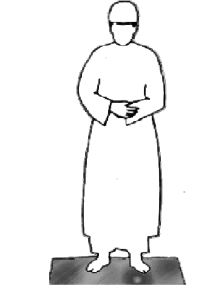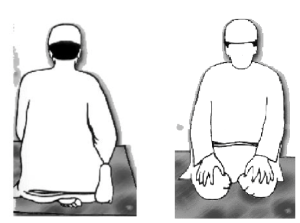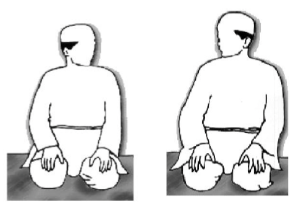Method of Salaah
Lesson Fourteen
METHOD OF PERFORMING NAMAAZ
1. With Wudu, face towards the Qibla and stand so that there is a gap of four fingers between your feet.
2. Take each hand to each ear and touch the lobes of the ears with the thumbs and leave the rest of the fingers in their normal state, don’t join them together or spread them apart.
3. Face the palms of the hands towards the Qibla and your sight is to look at the sijdah. Then make a firm intention in your heart as to which Namaz you are praying and while saying ‘Allahu-Akbar’, lower your hands and join them below the naval. The way to join the hands is to have the palm of the right hand on top of the back of the left hand wrist, keep the middle three fingers straight and circle the left wrist with the thumb and the little finger firmly grasping the hand.
4. Then pray ‘Thanaa’
5. Then pray Ta’awwuz meaning “A’oozu Billahi Minash Shaitaanir Rajeem” and then pray Tasmee’a meaning “Bismillah’hir’rahman’ir’Raheem”.
6. Then pray the whole of the Surah Fatiha and say ‘Ameen’ quietly.
7. After this, pray any Surat or three ayats or one ayat which is equivalent to three small ayats.
8. Then whilst saying Allahu-Akbar go into the Rukooh. Grasp the knees with the hands and spread your fingers over the knees. Keep your back straight and your head level with your back and make sure that you are not too far up or kneeling to low down and keep your sight on your feet and pray at least three times “Subhana Rabbi’al Azueem’ and then pray this whilst standing up ‘Sami Allahu Liman Hamidah’ and if you are praying Namaz alone then also say ‘Rabbana lakal Hamd’…then while saying Allahu-Akbar go into the Sajdah.
9. The way to do this is to first put your knees on the ground, then put your hands at the side of the place where you are going to put your head and then place your head by first placing your nose on the ground and then your forehead and then press hard on your nose. Look towards your nose and keep your elbows up so that they don’t touch the ground and leave a gap between your armpits and make sure there is a gap between your thighs and your stomach. Place all your toes so that their tips are pointing towards the Qibla and their bases are flat on the ground. Keep your hands flat and have your fingers pointing towards the Qibla. Then pray at least three times ‘Subhana Rabbi al A’ala’.
10. Then lift your head up while saying Allahu-Akbar with first lifting your forehead then your nose then your face and then your hands. Keep your right foot upright and lay your left foot flat and sit on it firmly. Place your hands on your knees with the finger tips pointing towards the Qibla and the palm of your hands flat near your knees and the base of the fingertips laid flat at the end of your kneecaps.
11. Then whilst saying ‘Allahu-Akbar’ go back into the Sajdah and this is done in the same way as the first one. Then stand up by placing your hands on your knees and putting pressure on your knees and legs stand upright, don’t put your hands on the ground to assist you to stand up.
12. Now pray only ‘Bismillah’ir’ Rahmaan’ir’ Raheem’ and then surah Fatiha and another Surat and as before, perform Rukooh and Sijdah.
13. When getting up from the second Sajdah leave your right foot upright and lay your left foot flat and sit upright. And pray the tasahhud.
14. When you are reaching La’ilaaha make a circle in your right hand by joining the thumb with the middle finger and curl the small and it’s adjacent finger with the middle finger and on the word Laa lift your index finger but don’t move side to side and when you reach ‘illallahu’ straighten your hand back to normal.
15. Now if you have more than two Rakats to pray then stand back up and pray more Rakats, but for a Farz Namaz there is no need to join another Surat after surah Fatiha.
16. When you reach your last Qaidah (sitting position) pray Tashahhud and then pray the Durood Sharif called Durood-e-Ibraheem.
17. Pray the Dua after Durood Ibraheem known as Dua Masoora.
18. Turn your head towards your right shoulder and say ‘Assalamu Alai’kum Warah’matullah’ and then turn your head towards your left shoulder and repeat the same words again.
19. The Namaz has now finished, so raise both your hands and pray any Dua for example’Allahumma Rabbana Aatina Fid Duniya Hasanataw Wafil Akhirati Hasanataw Wa Qina Azaaban Naar’ then rub your hands over your face.
20. This is the method for an Imam or a male praying Namaz on their own. If however, you are a Muqtadee meaning praying in congregation (Jamaat) and behind an Imam then don’t perform Qiraa’at meaning don’t pray ‘surah Fatiha’ or a Surat, whether the Imam is praying loudly or quietly. Qiraa’at is not allowed in any Namaz if it is being prayed behind an Imam, as the Imaams Qiraa’at is sufficient for the follower.
Method of Namaaz for females is different
1. If the Namazee is a female then at the Takbeer-e-Tahrima she should lift her hands only upto her shoulders and then place her left hand on her chest and the right hand on top of it.
2. When performing Rukoo she should only bend a little so that her hands reach her knees and she should not put pressure on her knees and keep her fingers tightly together and not to straighten her back like males.
3. When performing Sajdah she should crawl up and perform Sajdah so that the arms are joined with the sides, her stomach is joined with her thighs and her thighs are crawled up with her shins and her feet are pointing outwards and are flat.
4. In Qaidah she should have both her feet pointing outwards towards the right and are flat. She should sit on her left buttock and keep her hands in the middle of her thighs.
THE PRACTICAL ACTIONS OF THE 5 DAILY NAMAZ – BROKEN DOWN INTO ACTIONS & RULINGS
TAKBEER-E-TAHREEMA
FARDH:
1. Takbeer-e-Tahreema
WAAJIB:
1. When starting the namaz, saying the Takbeere- Tehreema with the words Allahu Akbar” – you have to hear yourself saying it otherwise it will not be counted as said
 SUNNAH
SUNNAH
1) Rasing the hands upto the ears for the Takbeer-e-tahreema
2) The muqtadee (follower) to match his takbeer-e-tahreema with that of the imam
3) Not to spread or close the fingers but to leave them in their natural position, except in the state of ruku as you have to hold the knees
MUSTAHAB
1) To stand up for Salaah when mukabbir says: Hayya – alal- falaah (for both Imaam and muqtadee).
2) To start Salaah after Iqaamat, however Salaah may be started with: Qad qamatis- salaah.
3) To start salaah along with Imaam.
4) To make Niyyat (Intention) for Salaah in the Arabic language.
5) The hands not to be covered by clothes (sleeves) at the time of Takbeere- tahreema- for men.
6) The hands are to be covered by clothes (sleeves) at the time of Takbeere- tahreema- for women.
7) To perform salaah directly on the ground instead of prayer-carpet.
37 www.GardensOfSunnah.co.uk
 QAYAM
QAYAM
FARDH
1. Qayam– To stand upright in namaz for the duration of the fardh Qiraat.
WAAJIB
1) To pray the full surah Fatiha only once in each rakah of your namaz.
2) After finishing surah Fatiha and before starting to pray a surah- not to pray anything in between except for ‘Ameen’ and ‘Bismillah’.
3) To recite a surah or some verses of the
Holy Quran after Surah Fatiha- this is done in the first 2 Rakah’s of every Fardh namaz and every rakah of witr, sunnah and nafl namaz.
4) To go into ruku as soon as qiraat is finished.
SUNNAH
1) To put the right hand over the left hand under the navel
2) To read the thana
3) To read the ta’awwuz
4) To read the tasmiya (Bismillah), in the beginning of every rakat before surah Fatiha
5) to say ameen (for the individual, follower and the imam), after the recitation of Fatiha, ameen means ‘ (Oh Allah) accept our prayer’
6) The saying of tahmeed for the follower and the individual, the Beloved Prophet (Peace and blessings be upon Him) said: “when the imam says ‘Sami Allahuliman hamidah’, you should say ‘Rabbana lakal hamd’.
7) to read the thana, ta’awwuz, ameen and tahmeed all silently
8) To be standing straight at the time of takbeer-e-tahreema till its completion and not to be bowing the head
9) The imams takbeer-e-tahreema, tasmee’ ( sami Allahuliman hamidah) and salaam should be audible for the followers. As for the followers and an individual it is enough to say it silently, in such a way that one hears it himself
10) The feet should be about four fingers apart whilst standing
MUSTAHAB
1) To look at the at the place where you are going to do sajdah whilst in qayaam
2) To recite tasmiyah (Bismillah) prior to recitation of any surah, if started from beginning after surah Fatiha.
RUKU
 FARDH:
FARDH:
1. Ruku- To bow down so you can hold the knees
SUNNAH:
1. To pray tasbeeh during the ruku’ and sajdah three time.
2. To put the hands on the knees and to spread out the fingers whilst in ruku.
3. The back should be flat during Ruku
4. The head should be straight and level to the back
MUSTAHAB:
1) To recite more than thrice or atleast 5 times the tasbeeh of ruku: Subnhana- rabbiyal- adheem.
2) To look between the feet in ruku.
QAWMA
 WAAJIB:
WAAJIB:
Qawma- meaning to stand up straight after ruku- you need to ensure you are completely straight before going down for sajda.
MUSTAHAB
To look at the at the place where you are going to do
sajdah whilst in qayaam.
SUJOOD
FARDH:
1) Sujood– To ensure the forehead (and the nose) is firmly pressed on the floor, at least one toe of each foot to be flat so that its base is touching the ground and facing towards the Qibla
WAAJIB:
1) When doing sajdah- do one after the other and one should make sure they sit again properly but don’t delay the sitting position – no more than one rukn, meaning the time it takes to say subhanallah 3 times.
2) When in sajdah- you need to ensure that three toes (the big toe and the two after) are flat firmly pressing on the ground pointing towards the qibla.
SUNNAH:
1) To put the knees first, then hands, then the nose, then the forehead on the ground when prostrating. The opposite applies when rising from the prostration.
2) To have the face between the 2 hands whilst prostrating.
3) For men: the abdomen should not touch the thighs, and the elbows should not touch the sides, and the arms should be raised from the ground.
MUSTAHAB:
1) To recite more than thrice or atleast 5 times the tasbeeh of sujood: Subnhana- rabbiyal- a’laa.
JALSA
WAAJIB: 
1) Jalsa- meaning to sit between the two sajdah- one needs to ensure to return completely to a sitting position, before going for the next sajda.
SUNNAH:
1) To put the hands on the thighs whilst sitting (jalsa) between prostrations, and for tashahud ( qaidah).
2) To keep the right foot upright, such that the toes face towards the ka’baa and to sit on the left foot during the jalsa and qaidah
MUSTAHAB:
1) To recite the following in jalsah: Alaahummagh firlee war hamnee (for both imaam and muqtadee).
2) To look on your lap whilst in Jalsa
QAAIDAH-UULA AND AKHIRA 
FARDH:
1. Qaidah akhira- To sit in the last rakah, until the time it takes to complete the whole of tasha’hud
WAAJIB:
1) Qaidah-e uula- meaning the first sitting after 2 rakats, (where you pray tashahhud only). This is when one is praying a 3 or 4 rakah namaz, the first sitting will be Waajib and the last sitting (qaaidah-e akhirah) Fardh.
And in a 2 rakah namaz the fist sitting (qaaidah-e uula) will not apply, so the sitting after the 2 rakats will be Qaaidah-e- Akhirah and will be fardh.
2) To pray the whole of Tashahud is waajib, so ensure not to even leave a word out.
3) Not to continue praying after finishing Tashhahud in Qaaidah- e uula, in a Fardh, Witr or Sunnate- maukidah namaz. If you carried on by mistake and started to pray duroode- ibraheem and did not remember until you prayed until: Allahumma Salli Ala Sayyidina Muhammadin- then you will have to do sajdae- sahw. Please note: for the 4 sunnate- ghair maukiddah of Asr and Esha, you should pray duroode Ibraheeem after Tashaahud and then carry on your namaz and finish the last two rakah.
4) It is waajib not to perform qaidah before two rakahs or in the third rakah, if praying a 4 rakah namaz.- so in affect ensure to perform Qaaidah in the right times, which in the second rakah in a 2 rakah namaz, second and fourth rakah of a 4 rakah namaz and second and third rakah of a 3 rakah namaz ( witr waajib of Esha/ 3 fardh of Maghrib).
SUNNAH:
1) To put the hands on the thighs whilst sitting for tashahud ( qaidah)
2) To keep the right foot upright, such that the toes face towards the ka’baa and to sit on the left foot during the qaidah
3) To raise the right hands index finger during the tashahud, to raise it upon reciting “laa ilaaha”, and to lower it when reciting “illallah”.
4) To pray durood-e-ibraheem in the last qaidah
5) To read the dua-e-masoora after durood ibraheem
MUSTAHAB:
1) To recite durood- e Ibraheem where durood is to be recited
2) To say sayyiduna prior to the Holy names of the prophet hazrat Muhammad Mustafa (Sallallahu Alahi Wasallam) and of Hazrat Ibraheem (alaihi- salaam).
3) To look on your lap whilst in qa’idaah
SALAAM 
FARDH:
1) Khurooj-e-bi-sunoo’i- To perform an action after Qaidah-e-akhira (the last sitting) that would finish the namaz, i.e. performing salaam.
WAAJIB:
1)When performing salaam to finish your namaz, ensure that you also say atleast ‘Assalaam’, even when praying behind an imaam in Jamaa’t- as this is Waajib. The rest ‘ Alaikum warahmatullah’ is not waajib.
SUNNAH:
1) To turn the head to the right and then to the left, whilst doing the 2 salaams to finish off the namaz.
2) The imam should intend his Salam to those who are behind him in congregation, the angels and the righteous amongst the jinn. The follower should intend his Salam to the imam when he faces to the imam’s side, however if he is immediately behind the imam he should intend the 2 Salams to the imam, the people, the guardian angels and the righteous jinn. The individual should intend his salam to the angels alone.
3) The imam should lower the voice for the second salam.
4) The masbooq (late comer) should wait for the imam to finish the second salam before he gets up, to ensure that the imam doesn’t perform sajdah-sahw